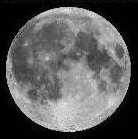Difference between revisions of "Luna"
(sp) |
|
(No difference)
| |
Revision as of 03:06, 3 March 2007

In general terms, a moon is any natural satellite of a planet. The Moon usually refers to the Earth's primary natural satellite, sometimes called Luna. The moon is of interest to space colonization advocates primarily because of the shallowness of its gravity well, its lack of atmosphere, the comparatively easy access to its natural resources, and its close proximity to Earth.
Contents
Physical Properties
The moon has an orbital radius of about 384,000 kilometers, and an orbital period of approximately 28 days. The moon is in a state of tidal lock, meaning that its rotation period is exactly the same as its orbital period, with the result that one hemisphere of the moon always faces the earth. On most parts of the moon, the lunar day is 14 Earth days long and lunar night is similarly 14 Earth days long. Since the moon is essentially airless, daytime and nighttime temperatures can be quite extreme, with daytime temperatures higher than 400 degrees Kelvin (250 degrees Fahrenheit) and nighttime temperatures lower than 100 degrees Kelvin (-250 degrees Fahrenheit).
Natural History
The moon formed approximately 4 billion years ago. The generally accepted theory of lunar formation, proposed by William K Hartmann and Donald R Davis, is that the moon was formed as a result of a large impact between the Earth and a Mars-sized object. The resultant ejecta formed an orbiting ring of debris around the Earth which eventually coalesced into the now familiar moon.
Exploration History
United States
Soviet Union
Europe
China
India
Resources






